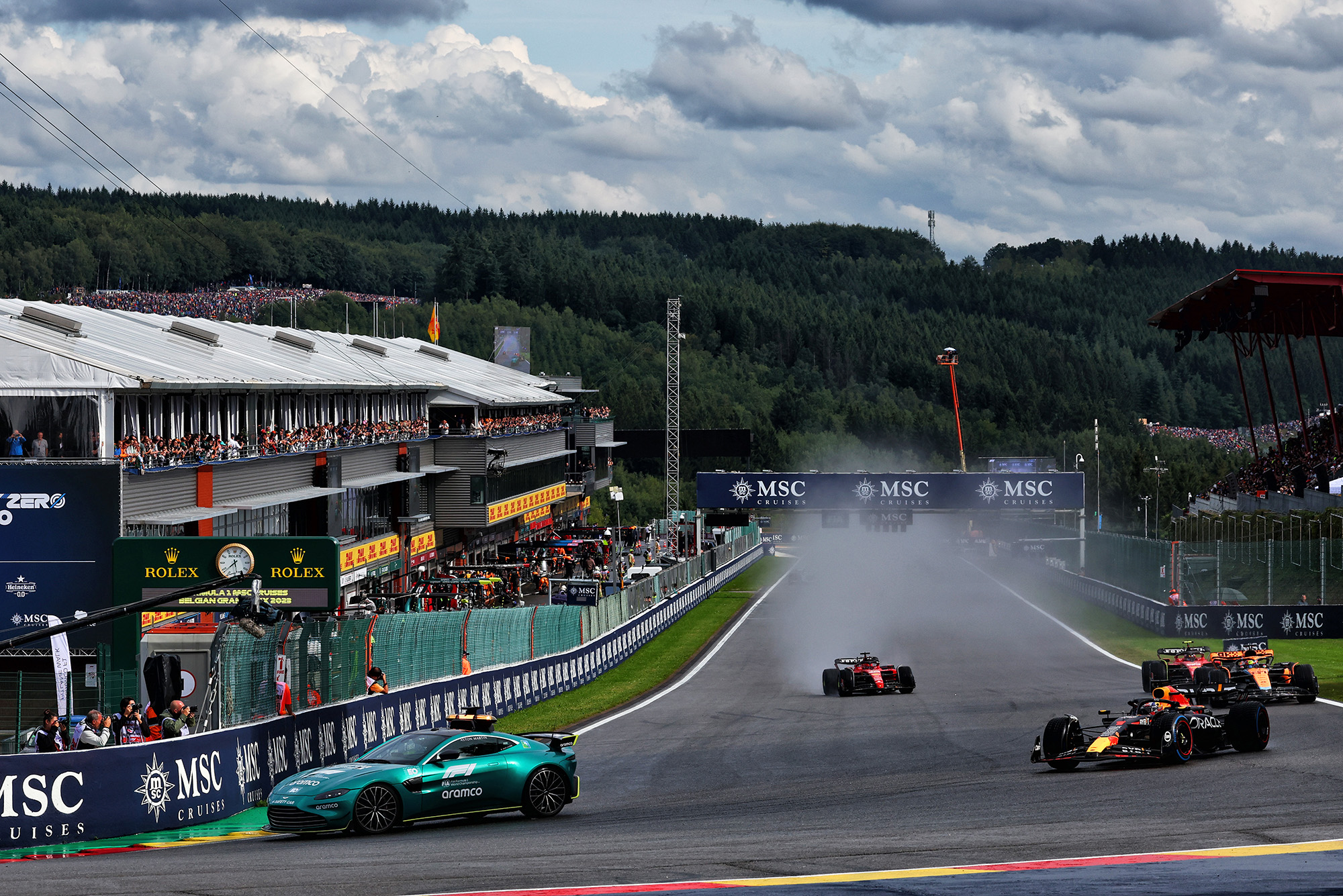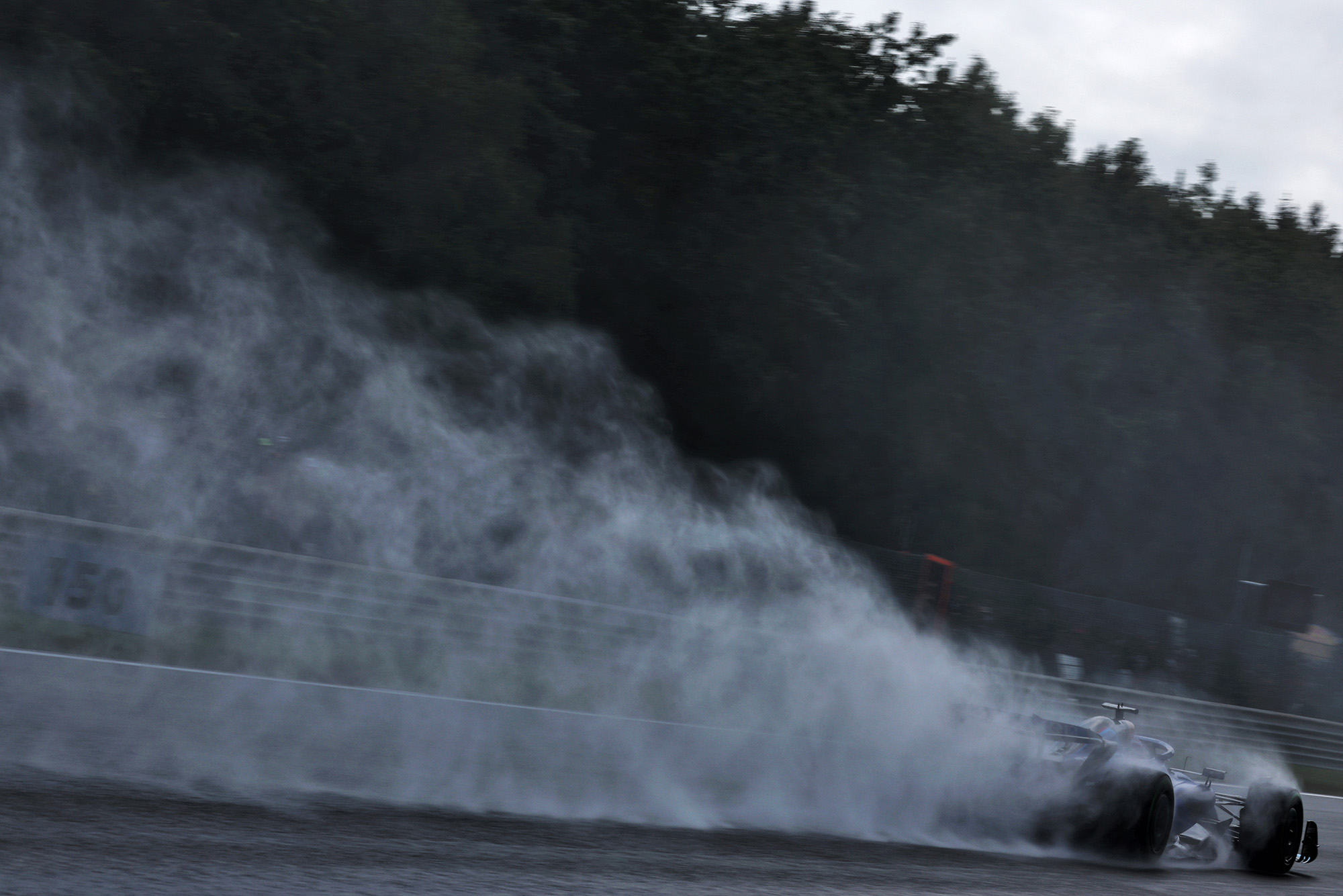Up Next

Pirelli is open to the idea of developing what have been dubbed “super-intermediate” tyres that would be used as a single specification of wet-weather rubber in Formula 1 following recent criticism from drivers.
But the situation is more complex than that criticism can make it sound, and progress may have to wait until it’s clear whether the FIA’s ‘spray guard’ project is going to pay off.
The performance of Pirelli’s wet F1 tyres has long been attacked by drivers, and the weather conditions during the Belgian Grand Prix weekend immediately before the current summer break provoked another round of frustrated comments.
Grand Prix Drivers’ Association chairman George Russell led the criticism, describing the wets as “pretty pointless” given their lack of grip that means drivers usually switch to intermediates for green-flag running. This has led to the wets largely being used only under the safety car.
Pirelli accepts it needs to improve its wet tyres, which clear the standing water well but don’t offer sufficient performance.
There are two main factors that mean the wets are mostly used under the safety car. Firstly, that the amount of spray creates big visibility problems, which is something that’s outside of Pirelli’s control, and tends to prompt safety car. Second, the fact the wet performance is not good enough once conditions are good enough in terms of visibility and green-flag racing is possible.
In testing, the current-specification wet tyre was around 15-16% off the pace at circuits such as Fiorano and Paul Ricard, where it’s possible to artificially soak the circuit. However, at high-speed Spa the wets were around 20% off the pace. That means the crossover point at which the intermediates must be taken is too early.
So the idea of switching to a single type of wet-specification tyres – the ‘super-intermediates’ – is one that has been tentatively discussed for the future.

Instead of the usual allocation of four intermediate and three wet sets (with the possibility for add-ons based on practice running) this could mean drivers having a larger allocation of the single super-intermediate spec. Pirelli also suspects this could have sustainability advantages.
The super-intermediate idea was discussed in the past, but shelved when the FIA launched its spray guard project designed to allow F1 to race in extreme wet conditions by improving the visibility.
That would necessitate keeping the current combination of intermediates and wets as the full wets would be needed for the more difficult conditions, but if that project cannot produce a workable package then Pirelli favours the switch to a single-spec of wets.
“If, for the future, the idea is to stay with the current situation that means if there is a lot of water on track, a red flag or a safety car and they are not going to run because of visibility, then in my opinion the best solution is probably to develop an intermediate tyre,” said Pirelli F1 boss Mario Isola.
“Let’s call it super intermediate or intermediate plus or whatever name you want to use.
“That is an intermediate that is more towards a wet condition, so we can cover with one product from the limit that is acceptable for visibility to the crossover with dry conditions.
“If the idea is to continue to look for a device that is able to reduce the spray and therefore give them the possibility to run in full wet conditions, we have to keep the two products, stay with the intermediate that we have now and improve the full wet tyre.
“But if the full wet tyre is used only behind the safety car, I agree with drivers that at the moment it’s a useless tyre.
“So we have to decide which is the direction we want to take for the future in order to develop the product that is needed for Formula 1.”

It’s unclear whether the idea of the single wet tyre specification would gain the support needed to be pursued, especially while the spray guards project is ongoing.
However, Pirelli believes that were it to be given the go ahead it would be possible to produce such tyres for introduction at some point during next season.
The need to run across a broad range of wet conditions means the tyre would require a modified tread pattern. Pirelli has worked on this in the past before the project was shelved.
“Luckily, we already have an idea of the tread pattern because we developed the idea in the past,” said Isola when asked by The Race about how long it would take to produce the super-intermediate tyres were F1 to make the change.
“But we have to produce moulds and it takes time.
“So probably we’re able to test the first version of these new tyres by this winter. If they are happy to change the tyre during the season – because consider that we have to start the production of the wet tyre for flyaways quite early in December – that means that we probably we cannot start the new season with a new tyre.
“But if they want to introduce it during the season then it’s possible.”
If a workable spray guards design cannot be hit upon then there is merit to taking this direction. However, it would require a change in mindset with F1 as a whole accepting that the visibility problems, which drivers believe have got significantly worse recently with the current generation of ground effect cars, mean that racing in extreme wet conditions is impossible.

In those circumstances, a super-intermediate tyre specification that works with the amount of water on track in the conditions that F1 can race in without hitting visibility problems and still performs well until the track is dry enough for slicks is a solution worth considering even though there are no imminent plans to make such a change.
That’s just one of many big decisions that F1 faces on tyres. First there are other big questions to be answered that could impact F1’s long-term tyre direction dramatically, notably who wins the tender to supply tyres from 2025 with Bridgestone and Pirelli both still in the running.





